Supply chains have recently seen unprecedented challenges due to the uncertain global scenarios and ever-increasing sustainability demands.
The manufacturing industry is embedded within the wider supply chain network and is, therefore, subject to enhanced exposure, but what does this mean for an industry that has historically operated in a globalized fashion?
Businesses are now struggling to balance globalization and localization of supply chain operations as they look to future-proof their operations. In either case, digitalisation is the critical enabler of growth. So how should manufacturers approach their digital transformation journeys?
This is where an innovation partner like HCLTech can lead the manufacturing supply chains toward a successful future.
Shankar Gopalkrishnan who has extensive experience in driving change among manufacturers to deliver better outcomes, explains how manufacturing organizations can best leverage technology to ensure successful business outcomes.
TS: Globalization vs localization. What are the pros and cons?
SG: The manufacturing industry will continue to progress on the foundations of digital, flexible, and green, which have been the core pillars for globalization. This will allow manufacturers to create more sustainable products faster and cheaper. Globalization also allows companies to establish synergies between regions, industries, and trading systems.
Extreme localization sounds right in the current situation. But when you consider the long-term effects, this approach will impact the product cost and fast-to-market product development, and disrupt the trade links and supply chains established over decades. The right equilibrium must exist in balancing localization efforts while improving and tightening globalization principles for promoting economic growth and vital business outreach to break into new markets.
TS: What has driven manufacturers to re-evaluate their sourcing strategies?
SG: The pandemic and supply chain constraints forced the manufacturing industry to rethink their sourcing strategies, with a focus on finding the right vendors to balance globalization and localization.
Strategic sourcing has pivoted to a new level, digging into all aspects that influence the value of sourcing. The traditional value drivers for strategic sourcing were built on the principles of cost, quality, scale and overall score carding. But the events over the last two years have exposed startling deficiencies. Now the procurement organizations in the manufacturing industry are heavily focused on establishing new baselines aligning toward response, agility, speed, visibility, broader product value chain, risk management, and suppliers who can address resiliency.
Sourcing organizations are also trying to create more outcome-based partnerships where suppliers can take a complete TCO-based approach to defined business outcomes. We at HCLTech are seeing a lot of customers doing some fundamental changes to their strategies toward sourcing on these outlined parameters, but to scale this, the clients are looking for next-gen digital infrastructure and applications to enable their vision.
TS: Is it likely that there will be a strategic approach to combine globalization and localization?
SG: Globalization to glocalization, is a very novel thought process. But, building such an ecosystem will take significant time, people, and money. While such thought-provoking measures are adopted in the long run, it is very important that the ecosystem does its part in laying out and adopting new policies that increase supply chain resilience. There must be necessary measures to build the infrastructure and risk mitigation strategies to stress-test supply chains on a periodic basis.
Supply chain agility is essential for the manufacturing industry to keep up with customer expectations of personalization and convenience. But, in many ways, agility remains only a buzzword as manufacturers lack the ability to quickly integrate local providers, adapt inventory, and rejig the value chains.
To change this, the manufacturers must adopt a strategic transformational mindset, creating the right balance to strengthen their local competencies alongside integration with the global hub through industry 4.0 and digital levers. The transformation of the systems used for production, transportation, and consumption would require a new way of thinking to enable manufacturers to scale further.
The globalization vs localization debate
Gopalkrishnan explains that, until now, global supply chain networks have created connections between regions and opened up more possibilities for manufacturers.
“Globalization has allowed companies to establish good collaborations between industries and different regions, as well as a trading ecosystem. But I think the challenges that we are seeing today are due to the supply chain issues—as well as the pandemic and geopolitical crises—forcing organizations to look at establishing local ecosystems,” says Gopalkrishnan.
In this process, stockpiles have been created to maintain some equilibrium to bridge this gap. In this scenario, a business strategy around localization against globalization makes sense.
While the case for localization seems the strongest option for supply chains, Gopalkrishnan also highlights that there are other variables that determine the success of supply chains in the current risk landscape.
Resilience and the health of the supply chain are essential metrics that we need to continue to measure and monitor as we move forward. Localization in the current scenario makes sense, but if you look at it from a long-term standpoint, we are already seeing that it is increasing the cost of products and will also impact the time for products to come into the market. Since global disruptions are the key factors driving manufacturers’ decisions, this is also the main focus of HCLTech as it operates within four manufacturing industry sub-verticals: Automotive, Industrial products, Chemicals and Electronics.
As a result of these disruptions, manufacturing companies are paying close attention to their supply chains and doubling down on the costs involved in production, while also creating contingency plans for material sourcing and transportation to limit potential downtime.
In particular, Gopalkrishnan says that firms are looking into transparency across their end-to-end value chains and alter their strategic sourcing approach toward better risk management.
We are seeing some fundamental changes in sourcing strategy to scale this entire ecosystem—right from the current traditional model to a next-generation sourcing model— focusing on visibility, speed, agility and robust infrastructure and applications to align to that vision. The new outlook on the supply chain, particularly in the eyes of manufacturers, is to consider all aspects of sourcing instead of targeting individual areas. This means a holistic approach to sourcing has become a necessity in risk mitigation.
Weighing up the benefits of both globalization and localization of supply chains is somewhat an endless debate. Thus, the proposal of Gopalkrishnan and the team at HCLTech is to consider what he calls a ‘glocalization’ model.
Creating more of an agile environment continues to be a challenge for a lot of manufacturers. It’s important they change their thought processes and move into a transformational mindset, which requires a balance of local and global competencies, through Industry 4.0 and digital transformation levers.
The benefits of digital in the supply chain
Global business has been the major catalyst for many organizations, driving them towards operational excellence, which provides a strong case for a globalized manufacturing outlook. But, to reach new heights and become more innovative, Gopalkrishnan says that the focus should turn toward the state of the market leveraging a more proactive approach to market disruptions.
This is where manufacturing companies are utilizing the latest industry 4.0 capabilities—along with the internet of things (IoT), to establish their digital transformation based on data.
“This will allow them to become more transparent in their operations, consistent and market-responsive. On this line, we are establishing and helping some of our manufacturing customers to create their digital plan, pivoting beyond the digital divide that is currently evident in the overall value chain. We’ve set up what we call ‘Manufacturing Vision’ or ‘MVision’, which can truly help them achieve unprecedented levels of digital adoption and become data-driven organizations” says Gopalkrishnan.
As a well-established digital solutions provider for manufacturers around the world, HCLTech created a comprehensive framework for the manufacturing industry through MVision which is built on the principles of a hyper connected digital-enabled enterprise.
The MVision framework allows organizations to adopt and deploy solutions across the entire value chain, focusing on people, process, and technology. MVision has been constructed to provide visibility from shop-to-top floor by integrating the broader ecosystem of customers, partners, and employees. The integration allows organizations to tap into opportunities to increase top line through new business models and improve bottom line by breaking silos.
The MVision transformational framework is built on four fundamental pillars – MVision for Business, MVision for Digital, MVision for Engineering, MVision for Operations.
The first pillar, MVision for Business helps define and execute digital process and digital strategies to enhance customer, partners, and employee experiences. It aims to build systems that drive business transformation to create process optimization, experience, and product orientation.
The second pillar, MVision for Digital helps design and build the platforms that use AI, ML, and other capabilities for creating mechanisms within our customers’ technology footprint to empower their digital transformation journey through our MVision for Business.
The third pillar, MVision for Engineering focuses on assisting manufacturers in accelerating product development by leveraging their latest technologies, monetizing their product services, and providing immersive customer experiences.
The fourth pillar, MVision for Operations provides an integrated applications and infrastructure services in a high velocity, software driven agile operating model At the core of MVision framework, is MVision Nucleus, powered by the critical components of industry 4.0 that focuses on creating an intelligent and connected ecosystem through connected assets and connected products. This drives digital transformation across the connected value chain of the manufacturing industry.
The first goal to consider when implementing the four pillars revolves around smart manufacturing principles. As companies see the opportunities arising from industry 4.0, they require the expertise to get the most out of their connected solutions.
The next area is supply chain visibility, which is a critical capability for all businesses as they strive for sustainability, while minimizing risks in their value chains. HCLTech is heavily involved during the implementation stage to ensure careful alignment with their digital plan. HCLTech is determined to invest in clients’ roadmap and aim to help adopt new technologies with complete transparency.




